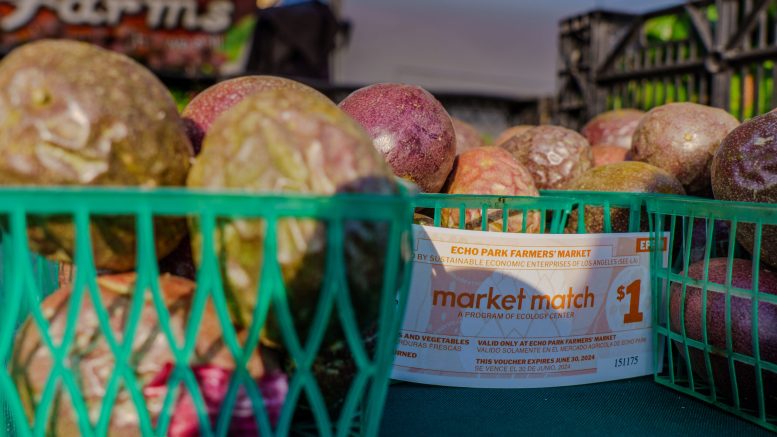The state has matched fruit and vegetable purchases at farmers markets for low-income residents for seven years. That may soon end.
By George B. Sánchez-Tello, Capital & Main
This story is produced by the award-winning journalism nonprofit Capital & Main and co-published here with permission.
Cris Oliveros and Dennise Sanchez, both 30, pick through Pink Lady apples and Cara Cara oranges at the Huntington Park Farmers Market in Southeast Los Angeles. Oliveros works as a barista at a hotel in downtown Los Angeles; Sanchez delivers for DoorDash. Both qualify for CalFresh, the state’s food-support program for low-income earners. At the farmers market, they can stretch CalFresh benefits with Market Match, an innovative state program that matches dollar-for-dollar CalFresh spending at farmers markets and farm stands. Oliveros said the extra $20 from Market Match allows him to get fruit and vegetables, freeing up CalFresh funds so he can buy 32 eggs for $18.
But in early January, Gov. Gavin Newsom announced plans to cut approximately $37.8 billion dollars in the 2024-2025 state budget, including $33.2 million of Market Match’s $35 million budget — effectively eliminating the program. Asked how Newsom’s decision would affect them, the couple responded quickly.
“We would return, but we can’t get as much,” Oliveros said.
Since 2017, California has matched CalFresh money spent at participating farmers markets across the state through Market Match. CalFresh — which used to be called food stamps — offers up to $291 monthly to individuals who earn less than $18,954 annually. People with CalFresh EBT (electronic benefit transfer) cards can go to a participating farmers market and find the Market Match table. At the table, they run their card through an automated teller, decide how much to spend and get vouchers for the selected amount. Market Match managers will offer coupons matching up to $20 withdrawn from CalFresh recipients’ EBT card, which can be presented to vendors and at farm stalls. Cardholders leave with fresh fruits and vegetables while the farmers later redeem the coupons for money. Cardholders can use the funds once a day at a participating farmers market.
Market Match is overseen by a consortium of farmers, food policy organizations and farmers market managers. Minni Forman, who leads the California Market Match Consortium, said more than 500,000 people use the program, often feeding multiple members of their families. The consortium estimates the program led to $19.5 million spent on California farm produce in 2022. That money went back to farming communities in places like Fresno, Monterey and Tulare counties.
“This is more than a safety net; it’s an economic stimulator for rural California,” Forman said.
The initial Market Match pilot program began with private funding at 14 markets in 2009. Last year, Market Match was available at 293 farmers markets and farm stands and supported through state and federal funds.
Karen Ross, California’s secretary for the Department of Food and Agriculture, said the program was specifically meant to benefit communities identified as food deserts — communities suffering food apartheid through the lack of markets with fresh fruits and vegetables and the abundance of unhealthful processed food — by connecting them with small farmers. Ross estimates Market Match has delivered $90 million in benefits over the life of the program to California small farms.
Erin Tormey, who owns Irish Ridge Ranch in Half Moon Bay and helped start farmers markets in Half Moon Bay and Pacifica, said farmers can earn about $6,000 from Market Match at the Coastside Farmers Market during the selling season, which runs from April to December.
“Countless numbers of people are better nourished and kept out of poverty because of this program,” Tormey said.
When Newsom announced the proposal to cut $33.2 million of the program’s $35 million cost — effectively ending the program — many food policy organizations were surprised that such a successful program was targeted. But Ross explained the program is supported through onetime appropriations, grants, matching federal funds — $12.898 million in 2022 — and federal aid from the COVID-19 pandemic. There has never been permanent state funding, she said.
“It was a hard decision,” Ross said. “We were clear-eyed; this reduces our chance of applying for federal funds this year.”
California has been able to maximize support for Market Match through federal grants. But if the state doesn’t commit funds, it cannot qualify for matching grants from the U.S. Department of Agriculture.
That California would forgo matching federal funding to help feed people who qualify for food aid is “unconscionable,” Tormey said.
“Why would a governor leave federal matching funds on the table?” Tormey asked.
Newsom’s announcement in January was tentative. Budget negotiations will continue until May. By June, the state has to adopt a final budget for the next fiscal year. In the meantime, Ross notes there is a strong coalition of elected officials, farmers, customers and food policy experts who will advocate to save Market Match.
In the days following Newsom’s announcement, food policy organizations have been communicating, starting to strategize and using social media to raise awareness. The Market Match consortium created a website, encouraging people to sign their petition and contact state legislators. The managers of the Huntington Park Farmers Market are creating a QR code and petition for residents and customers like Oliveros and Sanchez.
Oliveros noted that farmers markets that offer Market Match are often in low-income communities of color.
“What do you call it? Equity,” said Oliveros. “We’re able to have fresh fruits and vegetables.”
Copyright 2024 Capital & Main


Be the first to comment on "California plans to eliminate a healthful-food program that has served both farmers and low-income residents"